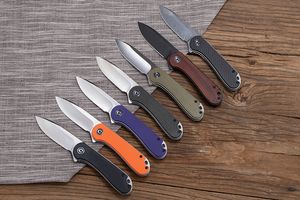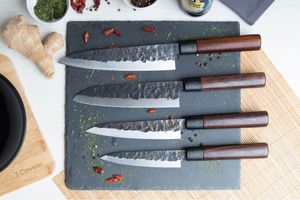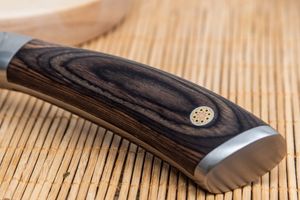In this article, we will help you understand the two main categories:
- European knives: Universal, durable, familiar.
- Japanese knives: Specialized, sharp, graceful.
1. Steel:
- Europe: Uses softer steel (54-58 HRC). Knives are easier to sharpen, but they dull faster.
- Japan: Harder steel (59-64 HRC). Holds an edge longer, but more fragile.
2. Sharpening:
- Europe: Double-sided (20° per side). The blade is thicker, suitable for different products.
- Japan: Single-sided (15°). The blade is thinner, ideal for precise cutting.
3. Shape:
- Europe: Universal models. Chef's knife, bread knife, santoku, vegetable knife.
- Japan: Specialized models. Santoku, deba (for fish), yanagiba (for fillet), nakiri (for vegetables).
4. Handle:
- Europe: Ergonomic, made of wood, plastic or steel.
- Japan: Traditional, wooden. Lightweight, but may be uncomfortable for some.
5. Price:
- Europe: Wide range of prices, from budget to premium.
- Japan: Generally more expensive due to more labor-intensive production.
Which type of knife to choose?
- European: Suitable for beginners, versatile, practical.
- Japanese: For experienced users who value sharpness and precision.
Important:
- Not all knives in the category are the same. Study the characteristics of a specific model.
- Think about your needs, work style and budget.
- Don't be afraid to try something new!
We hope this article has helped you understand the differences between European and Japanese knives.
In the online store https://osakahamono.com.ua/en, you will find a wide selection of knives for every taste and budget.
Come to us and we will help you choose the perfect knife for your kitchen!




















